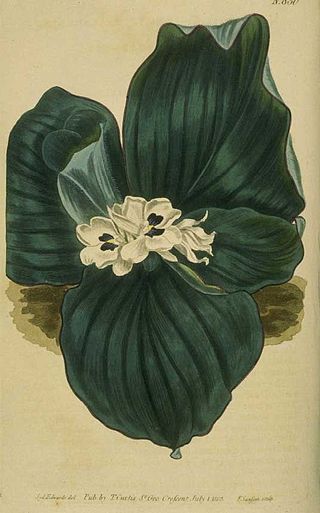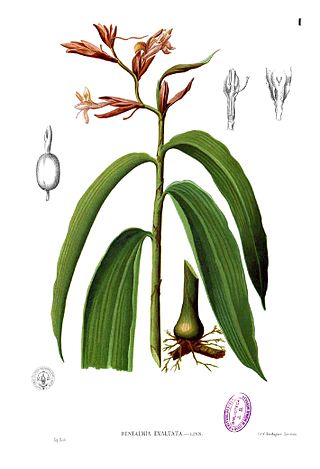
Zingiberaceae or the ginger family is a family of flowering plants made up of about 50 genera with a total of about 1600 known species of aromatic perennial herbs with creeping horizontal or tuberous rhizomes distributed throughout tropical Africa, Asia, and the Americas. Many of the family's species are important ornamental, spice, or medicinal plants. Ornamental genera include the shell gingers (Alpinia), Siam or summer tulip, Globba, ginger lily (Hedychium), Kaempferia, torch-ginger Etlingera elatior, Renealmia, and ginger (Zingiber). Spices include ginger (Zingiber), galangal or Thai ginger, melegueta pepper, myoga, korarima, turmeric (Curcuma), and cardamom.

Galangal is a common name for several tropical rhizomatous spices.

Boesenbergia rotunda, commonly known as Chinese keys, fingerroot, lesser galangal or Chinese ginger, is a medicinal and culinary herb from China and Southeast Asia. In English, the root has traditionally been called fingerroot, because the shape of the rhizome resembles that of fingers growing out of a center piece.
Wild ginger may refer to any of a variety of plants, often with a similar appearance, odour or taste to cultivated ginger. Species involved include:

Alpinia is a genus of flowering plants in the ginger family, Zingiberaceae. It is named for Prospero Alpini, a 17th-century Italian botanist who specialized in exotic plants. Species are native to Asia, Australia, and the Pacific Islands, where they occur in tropical and subtropical climates. Several species are cultivated as ornamental plants. Species of the genus are known generally as shell ginger.

Alpinia purpurata, commonly referred to as red ginger, also called ostrich plume and pink cone ginger, are native Malaysian plants with showy flowers on long brightly colored red bracts. They look like the bloom, but the true flower is the small white flower on top.

Alpinia zerumbet, commonly known as shell ginger among other names, is a perennial species of ginger native to East Asia. The plants can grow up to 2.5 to 3 meters tall and bear colorful funnel-shaped flowers. They are grown as ornamentals and their leaves are used in cuisine and traditional medicine.

Costus is a group of herbaceous perennial plants in the family Costaceae, described by Linnaeus as a genus in 1753. It was formerly known as Hellenia after the Finnish botanist Carl Niclas von Hellens. It is widespread through tropical and subtropical regions of Asia, Africa, and the Americas.

Alpinia galanga, a plant in the ginger family, bears a rhizome used largely as an herb in Unani medicine and as a spice in Arab cuisine and Southeast Asian cookery. It is one of four plants known as "galangal". Its common names include greater galangal, lengkuas, and blue ginger.

Alpinia officinarum, known as lesser galangal, is a plant in the ginger family, cultivated in Southeast Asia. It originated in China, where its name ultimately derives. It can grow 1.5 to 2 m high, with long leaves and reddish-white flowers. The rhizomes, known as galangal, are valued for their sweet spicy flavor and aromatic scent. These are used throughout Asia in curries and perfumes, and were previously used widely in Europe. They are also used as a herbal remedy.

Kaempferia galanga, commonly known as kencur, aromatic ginger, sand ginger, cutcherry, is a monocotyledonous plant in the ginger family, and one of four plants called galangal. It is found primarily in open areas in Indonesia, southern China, Taiwan, Cambodia, and India, but is also widely cultivated throughout Southeast Asia.

Alpinia caerulea, commonly known as native ginger or Australian ginger, is an understorey perennial herb in the family Zingiberaceae which grows in rainforest, gallery forest and wet sclerophyll forest in eastern Australia.

Alpinia malaccensis is a plant in the family Zingiberaceae cultivated for ornamental and medicinal purposes. It is a native of Indonesia and Malaysia. An oil is obtained from dried rhizome. It has many medicinal properties.

Renealmia alpinia is a flowering plant species native to the Americas, where it grows from southern Mexico through much of South America, though not in the Southern Cone. It can also be found on several Caribbean islands.

Hellenia is a genus of plants in the Costaceae described as a genus with this name in 1791. It is native to Southeast Asia, southern China, the Indian Subcontinent, New Guinea, and Queensland. The type species was "H. grandiflora" Retz., which is a synonym of Hellenia speciosa.
Alpinia elegans is a species of flowering plants in the ginger family, Zingiberaceae. It is found in Asia.
Rosemary Margaret Smith (1933–2004) was a Scottish botanist and illustrator who specialized in the taxonomy of the Zingiberaceae, or ginger family. Many of the species she classified and identified as being placed into improper genera were found in Asian countries, especially in the isolated island of Borneo.
Alpinia javanica, the Javanese alpinia, is a species of ginger occurring from Thailand to Malesia. It was first described by Carl Ludwig von Blume.
Alpinia petiolata, the stalked-leaved alpinia, is a species of ginger native to Peninsular Malaysia. It was first described by John Gilbert Baker.

Alpinia arctiflora, commonly known as the pleated ginger, is a plant in the ginger family Zingiberaceae which is endemic to northeastern Queensland.













